Some daily events in the changing sky for March 26 – April 3.
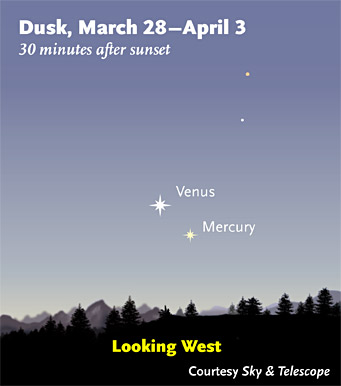
Bright Venus and lesser Mercury form an eye-catching pair low in the western twilight. You're free to copy and repost this image to do some astronomy outreach! Just be sure to include a link to SkyandTelescope.com.
Sky & Telescope magazine
Friday, March 26
Saturday, March 27
is calling on its members to participate.
So if it's clear this evening, stick your head out after 8:30 and see if the sky looks a bit darker. I doubt it will, especially because the bright gibbous Moon will be up! However, some cities have made serious Earth Hour efforts in the four years since the movement began, and skywatchers in those places have reported seeing a genuine (if short-lived) improvement in sky quality.
Sunday, March 28
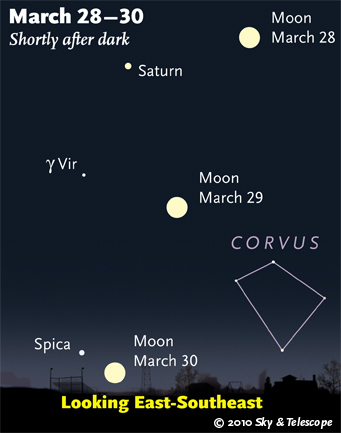
Watch the big bright Moon pass Saturn, Gamma Virginis, and Spica on its nightly eastward march.
Sky & Telescope diagram
Monday, March 29
Tuesday, March 30
Wednesday, March 31
Thursday, April 1
Friday, April 2
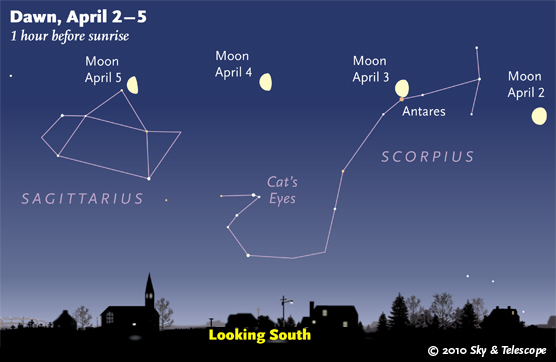
In early dawn the waning Moon crosses Scorpius and Sagittarius. For clarity, the Moon is drawn three times actual size. It's positioned as seen at the time of dawn near the middle of North America (at latitude 40° north, longitude 90° west).
Sky & Telescope diagram
Saturday, April 3
Three reasons conspire to make Venus shine so brightly despite its greater distance right now. It’s about twice as big a planet as Mercury, it’s covered with brilliantly reflective white clouds compared to Mercury’s dark gray rocks and dust, and Venus is currently showing us more of its sunlit dayside.
ADVANCE NOTICE: Asteroid to occult bright star for Los Angeles, Far West, night of April 5–6.
The easy naked-eye star Zeta Ophiuchi, magnitude 2.5, should be occulted for up to 8 seconds by the faint asteroid 824 Anastasia early on the morning of Tuesday, April 6th, along a narrow path running from Southern California through Idaho and then western Canada. The shadow path is predicted to run right across the Los Angeles basin, and across or near Calgary and Edmonton in Canada. See Steve Preston's maps and other data for this event.
The International Occultation Timing Association hopes to recruit many observers from the public, since anyone can see Zeta Oph blink out and reappear with nothing but their eyes! IOTA has set up a special Anastasia occultation page for people who have never tried watching or timing one of these events.
More to come.
Want to become a better amateur astronomer? Learn your way around the constellations. They're the key to locating everything fainter and deeper to hunt with binoculars or a telescope.
Sky Atlas 2000.0 (the color Deluxe Edition is shown here) plots 81,312 stars to magnitude 8.5. That includes most of the stars that you can see in a good finderscope, and typically one or two stars that will fall within a 50× telescope's field of view wherever you point. About 2,700 deep-sky objects to hunt are plotted among the stars.
Alan MacRobert
For an easy-to-use constellation guide covering the whole evening sky, use the big monthly map in the center of each issue of Sky & Telescope, the essential magazine of astronomy. Or download our free Getting Started in Astronomy booklet (which only has bimonthly maps).
Once you get a telescope, to put it to good use you'll need a detailed, large-scale sky atlas (set of charts; the standards are Sky Atlas 2000.0 or the smaller Pocket Sky Atlas) and good deep-sky guidebooks (such as Sky Atlas 2000.0 Companion by Strong and Sinnott, the more detailed and descriptive Night Sky Observer's Guide by Kepple and Sanner, or the classic Burnham's Celestial Handbook). Read how to use them effectively.
Can a computerized telescope take their place? I don't think so — not for beginners, anyway (and especially not on mounts that are less than top-quality mechanically). As Terence Dickinson and Alan Dyer say in their Backyard Astronomer's Guide, "A full appreciation of the universe cannot come without developing the skills to find things in the sky and understanding how the sky works. This knowledge comes only by spending time under the stars with star maps in hand."
This Week's Planet Roundup
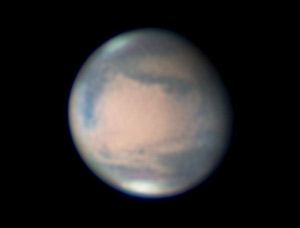
Mars was only 10.8 arcseconds wide on the evening of March 16th when S&T's Sean Walker took this image at 7:41 p.m. EDT. The North Polar Cap (bottom) seems to be diminishing. Note the cloud in Hellas (at the 11 o'clock position on the limb) and the apparent blue cloud over Syrtis Major (left limb). Walker used a DMK camera on a Celestron 14-inch Schmidt-Cassegrain scope. He writes, "One hour later, the seeing was so bad I couldn”™t be sure there was a polar cap on Mars!"
S&T: Sean Walker
Mercury and Venus have a fine pairing low in the west during twilight this week and next. Venus is by far the brighter of the two. This week, look for Mercury to its lower right, as shown at the top of this page.
Venus is magnitude –3.9. Mercury fades during this period; it's magnitude –1.3 on March 26th, –0.9 on April 1st, –0.5 on April 5th, and +0.3 on April 10th. They appear closest together (3°) on April 3rd and 4th.
This is as good an apparition as often-elusive Mercury ever puts on (for skywatchers at mid-northern latitudes). And with Venus lighting the way to it, you could hardly ask for Mercury to be any easier. P.S.: Think photo opportunity; use a fairly long lens to get a good image scale.
Mars, dimming into the distance at magnitude +0.1, shines very high in the south in early evening and in the southwest later. It's in Cancer, drawing away from Pollux and Castor in Gemini.
In a telescope Mars is gibbous and shrinking: from 9.7 to 9.0 arcseconds in diameter this week. The north polar cap remains its most visible marking. Identify other surface features you may see using the Mars map and observing guide in the December Sky & Telescope, page 57.
Jupiter is still deep in the glow of sunrise.
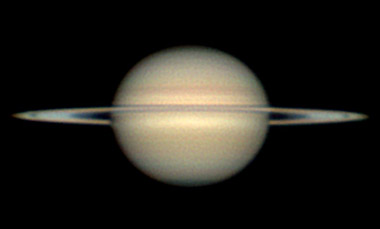
Now that Saturn is past opposition (which came on the night of March 21–22), its rings have reverted to their normal brightness. For a couple of days around opposition the rings brighten slightly due to backscattering of light toward the Sun and Earth (the Seeliger effect).
In other Saturn news, the Saturn Electrostatic Disturbance white spot in the southern latitudes seems to have faded out of view as quickly as it brightened. (It's on the far side of Saturn in this image, but other images no longer show it.) Christopher Go took this shot at 13:38 Universal Time March 24, 2010, in very good seeing. South is up.
Saturn (magnitude +0.6, in the head of Virgo) is just past opposition. Look for it low in the east-southeast at dusk, higher in the southeast by late evening, and highest in the south around midnight daylight saving time. In a telescope Saturn's rings are tilted only 2.8° from edge-on. They'll narrow to 1.7° in May and early June, then begin widening again.
Uranus and Neptune are hidden in the glow of sunrise.
Pluto (magnitude 14, in northwestern Sagittarius) is well up in the south-southeast before dawn.
All descriptions that relate to your horizon or zenith — including the words up, down, right, and left — are written for the world's mid-northern latitudes. Descriptions that also depend on longitude (mainly Moon positions) are for North America. Eastern Daylight Time (EDT) equals Universal Time (also known as UT, UTC, or GMT) minus 4 hours.
To be sure to get the current Sky at a Glance, bookmark this URL:
http://SkyandTelescope.com/observing/ataglance?1=1
If pictures fail to load, refresh the page. If they still fail to load, change the 1 at the end of the URL to any other character and try again.
*What's wrong with this prediction? Note the April 1 date.
 0
0
Comments
You must be logged in to post a comment.